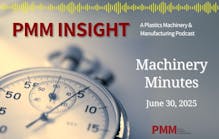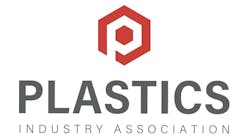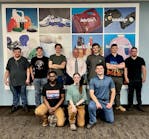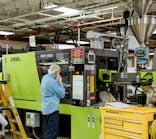Productivity on some extrusion lines can be significantly improved through use of a corrosion-resistant water treatment, said Peter Greenlimb, a water-management consultant whose company is called Chemagineering Corp., Rolling Meadows, Ill.
In a recently published patent application, Greenlimb said: "Manufacturers of water-cooled extruders generally advise those who purchase their equipment to use distilled, deionized or demineralized quality water 'properly treated' to prevent water-influenced corrosion and/or deposition of water-borne dissolved solids. … While the use of high-purity water as the cooling medium reduces scale deposition, the aggressive nature of this type of water at elevated operating temperatures and the large variations in water purity contribute to premature component corrosion and failure."
The number of outages at a multi-line sheet extruder in Ohio dropped from 54 to two per year after the company began using the water treatment, Greenlimb said in an interview. He estimated that eight to 10 extrusion companies now use the coolant.
The water treatment incorporates: (1) a yellow metal inhibitor for preventing corrosion and fouling of nonferrous metals forming the coolant-bearing passages; (2) an alkaline nitrogen-based compound to raise the pH of the water and reduce corrosion; and (3) a reducing agent to passivate the equipment's steel surfaces to reduce metal loss.
Exact formulations are based on the type of metals, ferrous and nonferrous, in a specific extruder's coolant system. Prices start at $20 per gallon for the coolant, which is sold in 55-gallon drums and totes. Extrusion Control & Supply Inc., a distributor in Waukesha, Wis., sells the coolant, which is produced by a contract manufacturer.
Patent application 20160090518; published March 31.
Other patent news:
IMM controller. Fanuc Corp., Minamitsuru, Japan, received a patent for an injection molding machine controller that detects abnormal electric voltage. This invention deals with concerns that power-supply devices can fail when electricity needs surge, particularly for the high-speed injection of a thin part and in high-speed clamping for compression molding.
Patent 9,339,963; issued May 17
Takeout robot. According to a patent for a Korean invention, takeout is accelerated and quality improved by measuring the weight of the injection molded part without an additional scale. In the new approach from Hanyang Robotics Co. Ltd., Incheon, South Korea, part weight is determined as part of the robot's normal conveying route through use of a load cell and other apparatus.
Patent 9,333,689; issued May 10
Injection stretch blow molding. New technology from Nissei ASB Machine Co. Ltd., Nagano, Japan, provides a 1.5-stage injection stretch blow molding machine that combines the advantages of both the one- and two-stage methods, saving energy and improving part quality.
Patent 9,333,695; issued May 10
Edge gating. Mold-Masters Ltd., Georgetown, Ontario, has received a patent for a technology that tackles problems associated with the edge gating commonly used to make parts such as pipettes or syringe barrels. In a typical system, a mold cavity has one gate through which material flows in a direction that is transverse to the longitudinal axis of the molded article. Fill speed and part geometry can be negatively affected. Several new potential approaches are outlined, including one involving bidirectional delivery of melt.
Patent application 20160114506; published April 28
Foam molding. A new approach to discharging gas in a mold cavity is outlined in an effort to reduce underfilling and improve productivity. The patent applicants are Bridgestone Corp., Tokyo, and Toyota Boshoku Corp., Kariya, Japan. Toyota Boshoku makes seats and other automotive components and is part of the Toyota Group.
Japanese patent application 2016-013674; published Jan. 28
Doug Smock, senior correspondent
Patents and patent applications can be viewed at http://appft.uspto.gov







